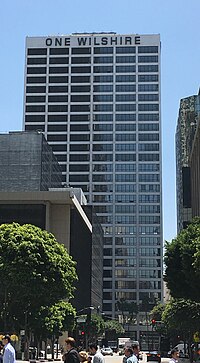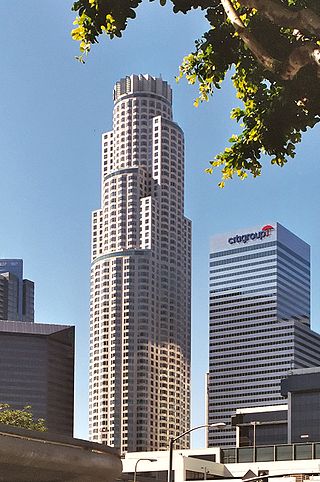
U.S. Bank Tower, known locally as the Library Tower and formerly as the First Interstate Bank World Center, is a 1,018-foot (310.3 m) skyscraper in downtown Los Angeles, California. It is, by structural height, the third-tallest building in California, the second-tallest building in Los Angeles, the 24th-tallest in the United States, the third-tallest west of the Mississippi River after the Salesforce Tower and the Wilshire Grand Center, and the 129th-tallest building in the world, after being surpassed by the Wilshire Grand Center. However, the U.S. Bank Tower does surpass both the Salesforce Tower and the Wilshire Grand Center in roof height, making it the only building in California whose roof height exceeds 1,000 feet (300 m). Because local building codes required all high-rise buildings to have a helipad, it was known as the tallest building in the world with a rooftop heliport from its completion in 1989 to 2010 when the China World Trade Center Tower III opened. It is also the third-tallest building in a major active seismic region; its structure was designed to resist an earthquake of 8.3 on the Richter scale. It consists of 73 stories above ground and two parking levels below ground. Construction began in 1987 with completion in 1989. The building was designed by Henry N. Cobb of the architectural firm Pei Cobb Freed & Partners and cost $350 million to build. It is one of the most recognizable buildings in Los Angeles, and often appears in establishing shots for the city in films and television programs.

Downtown Los Angeles (DTLA) is the central business district of Los Angeles. It is part of the Central Los Angeles region and covers a 5.84 sq mi (15.1 km2) area. As of 2020, it contains over 500,000 jobs and has a population of roughly 85,000 residents, with an estimated daytime population of over 200,000 people prior to the COVID-19 pandemic. Despite a business exodus from downtown Los Angeles since the COVID-19 pandemic, the district is evolving as a cultural center with the world's largest showcase of architecture designed by Frank Gehry.

The Williams Tower is a 64-story, 1.4 million square feet (130,000 m2) class A postmodern office tower located in the Uptown District of Houston, Texas. The building was designed by New York–based John Burgee Architects with Philip Johnson in association with Houston-based Morris-Aubry Architects. Construction began in August 1981, and the building was opened in 1983. The tower is among Houston's most visible buildings as the 4th-tallest in Texas, and the 44th-tallest in the United States. The Williams Tower is the tallest building in Houston outside of Downtown Houston, and is the tallest skyscraper in the United States outside of a city's central business district. It has been referred to as the "Empire State Building of the south".

Aon Center is a 62-story, 858 ft (262 m) Modernist office skyscraper at 707 Wilshire Boulevard in downtown Los Angeles, California. Site excavation started in late 1970, and the tower was completed in 1973. Designed by Charles Luckman, the rectangular bronze-clad building with white trim is remarkably slender for a skyscraper in a seismically active area. It is the third tallest building in Los Angeles, the fourth tallest in California, and the 58th tallest in the United States. The logo of the Aon Corporation, its anchor tenant, is displayed at the top in red.
Ohrbach's was a moderate-priced department store with a merchandising focus primarily on clothing and accessories. From its modest start in 1923 until the chain's demise in 1987, Ohrbach's expanded dramatically after World War II, and opened numerous branch locations in the New York and Los Angeles metropolitan areas. Its original flagship store was located on Union Square in New York City. It maintained administrative offices in Newark and in Los Angeles. The retailer closed the Newark offices in the 1970s. Paul László designed the Union Square store as well as many of their other stores.
A meet-me room (MMR) is a place within a colocation center where telecommunications companies can physically connect to one another and exchange data without incurring local loop fees. Services provided across connections in an MMR may be voice circuits, data circuits, or Internet Protocol traffic.
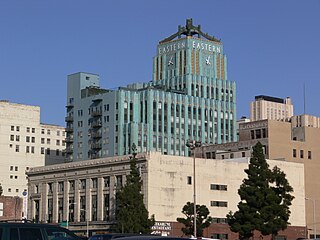
The Historic Core is a district within Downtown Los Angeles that includes the world's largest concentration of movie palaces, former large department stores, and office towers, all built chiefly between 1907 and 1931. Within it lie the Broadway Theater District and the Spring Street historic financial district, and in its west it overlaps with the Jewelry District and in its east with Skid Row.

Wilshire Boulevard (['wɪɫ.ʃɚ]) is a prominent 15.83 mi (25.48 km) boulevard in the Los Angeles area of Southern California, extending from Ocean Avenue in the city of Santa Monica east to Grand Avenue in the Financial District of downtown Los Angeles. One of the principal east–west arterial roads of Los Angeles, it is also one of the major city streets through the city of Beverly Hills. Wilshire Boulevard runs roughly parallel to Santa Monica Boulevard from Santa Monica to the west boundary of Beverly Hills. From the east boundary, it runs a block south of Sixth Street to its terminus.

The Homer Laughlin Building, at 317 South Broadway in Downtown Los Angeles, is a landmark building best known for its ground floor tenant the Grand Central Market, the city's largest and oldest public market that sees 2 million visitors a year.
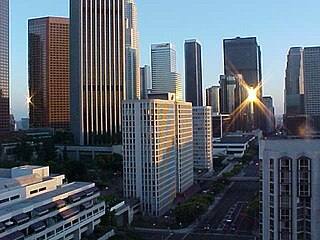
The Financial District is the central business district of Los Angeles along Olive, Grand, Hope, Flower and Figueroa streets from 4th Street to 8th Street. It is south of the Bunker Hill district, west of the Historic Core, north of South Park and east of the Harbor Freeway and Central City West. Like Bunker Hill, the Financial District is home to corporate office skyscrapers, hotels and related services as well as banks, law firms, and real estate companies. However, unlike Bunker Hill which was razed and now consists of buildings constructed since the 1960s, it contains large buildings from the early 20th century, particularly along Seventh Street, once the city's upscale shopping street; the area also attracts visitors as the 7th and Flower area is at the center of the regional Metro rail system and is replete with restaurants, bars, and shopping at two urban malls.

May Company California was an American chain of department stores operating in Southern California and Nevada, with headquarters at its flagship Downtown Los Angeles store until 1983 when it moved them to North Hollywood. It was a subsidiary of May Department Stores and merged with May's other Southern California subsidiary, J. W. Robinson's, in 1993 to form Robinsons-May.

The Westin Building Exchange is a major telecommunications hub facility located downtown Seattle, Washington. The building was constructed in 1981 as the Westin Building, housing the corporate offices of Westin Hotels, which was then based in Seattle. It is also home to the Seattle Internet Exchange (SIX) and Pacific Northwest Gigapop's Pacific Wave Exchange.

The Wilshire Boulevard Temple, known from 1862 to 1933 as Congregation B'nai B'rith, is a Reform Jewish congregation and synagogue, located at 3663 Wilshire Boulevard, in the Wilshire Center district of Los Angeles, California, in the United States. Founded in 1862, it is the oldest Jewish congregation in Los Angeles.
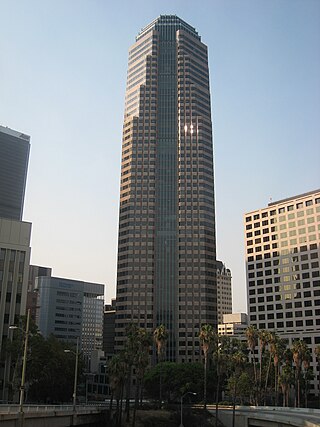
Figueroa at Wilshire, formerly Sanwa Bank Plaza, is a 53-story, 218.5 m (717 ft) skyscraper in Los Angeles, California, United States. It is the eighth-tallest building in Los Angeles. It was designed by Albert C. Martin & Associates, and developed by Hines Interests Limited Partnership. It won the Rose Award for "Outstanding New Office Building" in 1991. The tower was constructed from 1988 to 1990 on the site of the former St. Paul's Episcopal Cathedral.

Emery Telcom is a telecommunications company, which provides phone service, DSL service, cable TV and cable internet to much of eastern and south eastern Utah. Emery Telcom was founded in 1950 as a cooperative in Orangeville, Utah. It joined a consortium with four other Utah independent telephone companies to form Western FiberNet.

Wilshire Grand Center is a 1,100-foot (335.3 m) skyscraper in the financial district of downtown Los Angeles, California, occupying the entire city block between Wilshire Boulevard and 7th, Figueroa, and Francisco streets. Completed in 2017, it is the tallest building west of Chicago. Though the structural top of the Wilshire Grand surpasses L.A.'s U.S. Bank Tower by 82 ft (25 m), the roof of the U.S. Bank Tower is still 90 ft above the Wilshire Grand's. The Skyscraper Center lists the Wilshire Grand Center as the 15th-tallest building in the U.S. and the 95th-tallest in the world. It won the Structural Engineering Award 2019 Award of Excellence from the Council on Tall Buildings and Urban Habitat.

Salesforce Tower, formerly known as Transbay Tower, is a 61-story supertall skyscraper at 415 Mission Street, between First and Fremont Street, in the South of Market district of downtown San Francisco. Its main tenant is Salesforce, a cloud-based software company. The building is 1,070 feet (326 m) tall, with a top roof height of 970 feet (296 m). Designed by César Pelli and developed by Hines Interests Limited Partnership and Boston Properties, it was the last building designed by Pelli to be completed in his lifetime. As of 2024, Salesforce Tower is the tallest building in San Francisco and the second-tallest building both in California and west of the Mississippi River after the 1,100 feet (335 m) Wilshire Grand Center in Los Angeles.

7th Street is a street in Los Angeles, California running from S. Norton Ave in Mid-Wilshire through Downtown Los Angeles. It goes all the way to the eastern city limits at Indiana Ave., and the border between Boyle Heights, Los Angeles and East Los Angeles.

Retail in Southern California dates back to its first dry goods store that Jonathan Temple opened in 1827 on Calle Principal, when Los Angeles was still a Mexican village. After the American conquest, as the pueblo grew into a small town surpassing 4,000 population in 1860, dry goods stores continued to open, including the forerunners of what would be local chains. Larger retailers moved progressively further south to the 1880s-1890s Central Business District, which was later razed to become the Civic Center. Starting in the mid-1890s, major stores moved ever southward, first onto Broadway around 3rd, then starting in 1905 to Broadway between 4th and 9th, then starting in 1915 westward onto West Seventh Street up to Figueroa. For half a century Broadway and Seventh streets together formed one of America's largest and busiest downtown shopping districts.

165 Halsey Street, formerly known as the Bamberger Building, is a 14-story, office tower in Downtown Newark, New Jersey. Built in 1912–1929, it was designed by Jarvis Hunt. The building spans the entire block between Halsey Street, Market Street, Washington Street, and Bank Street. 165 Halsey Street is a major colocation center in New York metropolitan area; according to Center for Land Use Interpretation, it is among the world's largest carrier hotels. It is a contributing property to the Four Corners Historic District.
